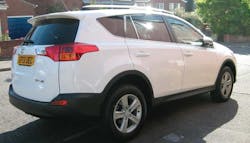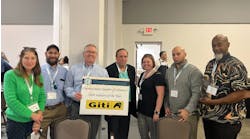Although I have worked in the tire industry for the past 20 years and have seen how most markets operate around the world, I have to admit to never really taking much notice of what is pumped into a tire to inflate it.
Everyone, not just in the tire business but right down to the ordinary car driver, knows that we inflate air into our tires and that has always seemed to be the case. However, during the course of this year I have noticed a debate slowly gathering a momentum of interest throughout Europe on whether filling our tires with nitrogen would be more beneficial.
At the moment when we inflate tires at a tire outlet or garage we are putting in compressed air, but now some experts consider that switching to nitrogen would be better while others contest this view. So, being of a very curious mind, I have looked at this subject more closely.
It is a known fact that purified nitrogen has been used to inflate tires on aircraft and Formula One racing cars for many years and the big argument raging across Europe is whether the recognized benefits for aircraft and racing cars can be handed down to ordinary street cars and vans. Planes now fly at heights where temperatures can be as low as -40 Celsius and tires are filled with pure nitrogen to eliminate them freezing which causes vibration and balance problems when landing. Also in European motorsport, pure nitrogen is used to combat moisture in tires by reducing tire temperature at maximum speeds.
My research has established that those who support the theory of changing to nitrogen promote the following two major benefits: using tires filled with nitrogen will ensure less corrosion in the tire because unlike air, there is no moisture in nitrogen; and there also will be a significantly slower rate of tire pressure loss as nitrogen molecules are larger that oxygen molecules (which make up 21% of compressed air).
On the other hand there is an equally emphatic group of experts who strongly contest these statements for the following reasons.
Nitrogen-filled tires do not hold pressure longer than air-filled tires as long as the tires are properly fitted and sealed. They will lose almost the same psi as air-filled tires.
Other equally important reasons given include: air is approximately 80% nitrogen and 20% oxygen with nitrogen being comparatively inert while oxygen is a reactive gas; and the nitrogen used for inflating tires is usually generated by a separation process from compressed air and still contains 5% oxygen.
It seems to me that the jury is still very much out when it comes to endorsing the use of nitrogen over compressed air when inflating tires in Europe.
I have also discovered that recognized roadside vehicle recovery services in Europe including the AA (Automobile Association) certainly do not recommend its members use nitrogen when inflating their tires.
What I also discovered is that the small but increasingly growing number of tire retailers and garages throughout Europe that offer an alternative tire inflation service in pure nitrogen do so at a more expensive price than compressed air. Far from appearing to sound suspicious or cynical, could this sudden endorsement of nitrogen-filled tires just be a way of earning even more profit from the motorist? I reckon given the choice, European drivers will always go for the cheaper option of air.
Obviously nitrogen-filled tires have worked for the aircraft and motor racing industries, but by the look of the evidence I have seen, there is still a fierce amount of doubt and objective criticism about nitrogen-inflated tires.
At the moment across Europe there is just a small amount of outlets offering pure nitrogen as well as/opposed to compressed air. If the ratio of tire retail outlets and garages offering nitrogen increases and becomes more balanced, then this development could mature into a major issue. ■
John Stone has been working within the global tire industry for the past 20 years. In 2004 he launched his own company, Sapphire Media Services, as a business media consultant with clients around the globe. Stone also writes for tire and automotive-related publications in Europe, South Africa and Asia.


